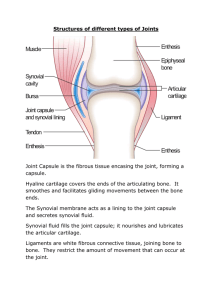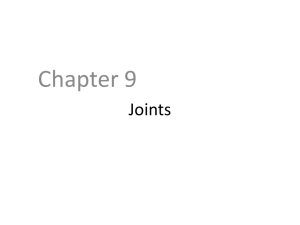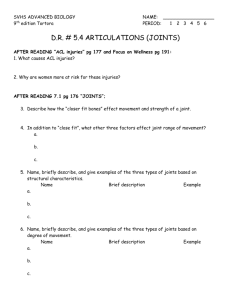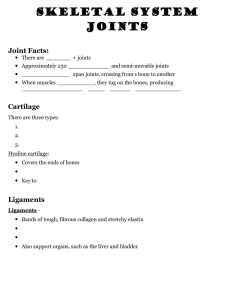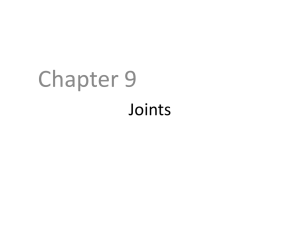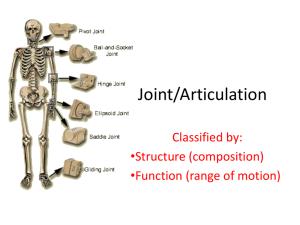An Introduction to Articulations Classification of Joints Articulations
advertisement
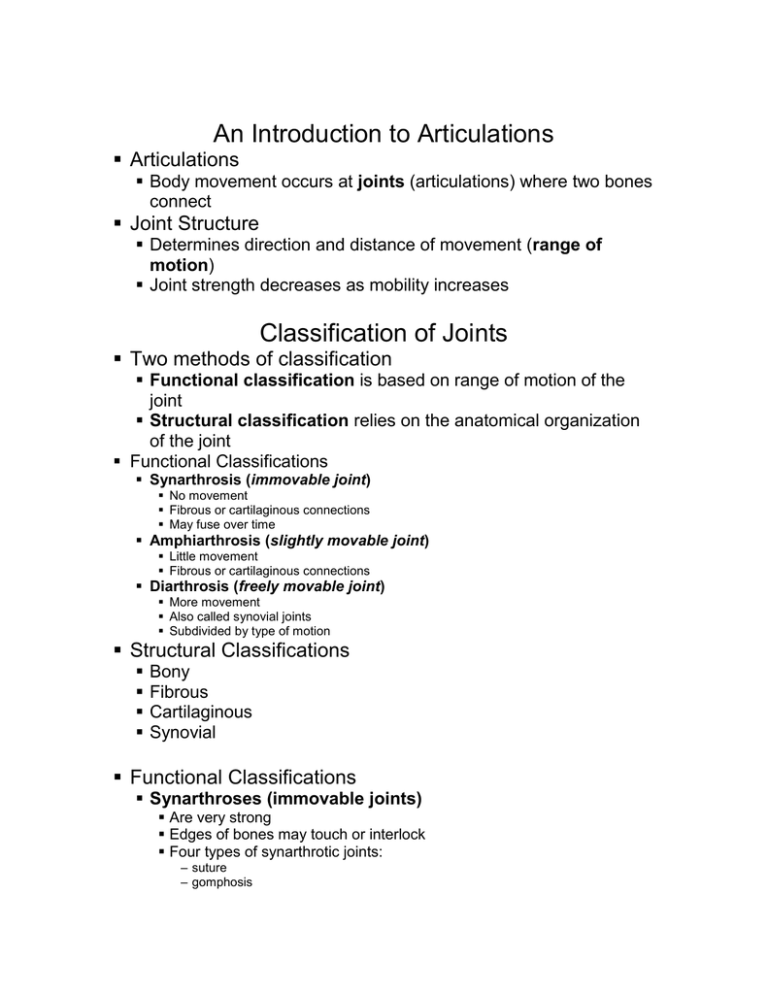
An Introduction to Articulations Articulations Body movement occurs at joints (articulations) where two bones connect Joint Structure Determines direction and distance of movement (range of motion) Joint strength decreases as mobility increases Classification of Joints Two methods of classification Functional classification is based on range of motion of the joint Structural classification relies on the anatomical organization of the joint Functional Classifications Synarthrosis (immovable joint) No movement Fibrous or cartilaginous connections May fuse over time Amphiarthrosis (slightly movable joint) Little movement Fibrous or cartilaginous connections Diarthrosis (freely movable joint) More movement Also called synovial joints Subdivided by type of motion Structural Classifications Bony Fibrous Cartilaginous Synovial Functional Classifications Synarthroses (immovable joints) Are very strong Edges of bones may touch or interlock Four types of synarthrotic joints: – suture – gomphosis – synchondrosis – synostosis Synarthrotic Joints Suture Bones interlocked Are bound by dense fibrous connective tissue Are found only in skull Gomphosis Fibrous connection (periodontal ligament) Binds teeth to sockets Synchondrosis Is a rigid cartilaginous bridge between two bones: – epiphyseal cartilage of long bones – between vertebrosternal ribs and sternum Synostosis Fused bones, immovable: – metopic suture of skull – epiphyseal lines of long bones Functional Classifications Amphiarthroses More movable than synarthrosis Stronger than freely movable joint Two types of amphiarthroses – syndesmosis: » bones connected by ligaments – symphysis: » bones separated by fibrous cartilage Synovial joints (diarthroses) Also called movable joints At ends of long bones Within articular capsules Lined with synovial membrane Synovial Joints Components of Synovial Joints Articular cartilages Pad articulating surfaces within articular capsules: – prevent bones from touching Smooth surfaces lubricated by synovial fluid: – reduce friction Synovial fluid Contains slippery proteoglycans secreted by fibroblasts Functions of synovial fluid: – lubrication – nutrient distribution – shock absorption Accessory structures Cartilages: – cushion the joint: » Fibrous cartilage pad called a meniscus (articular disc) Fat pads: – superficial to the joint capsule – protect articular cartilages Ligaments: – support, strengthen joints – sprain: ligaments with torn collagen fibers Accessory structures Tendons: – attach to muscles around joint – help support joint Bursae: – pockets of synovial fluid – cushion areas where tendons or ligaments rub Factors That Stabilize Synovial Joints Prevent injury by limiting range of motion Collagen fibers (joint capsule, ligaments) Articulating surfaces and menisci Other bones, muscles, or fat pads Tendons of articulating bones Injuries Dislocation (luxation) Articulating surfaces forced out of position Damages articular cartilage, ligaments, joint capsule Subluxation A partial dislocation Movements Types of Dynamic Motion Linear motion (gliding) Angular motion Rotation Planes (Axes) of Dynamic Motion Monaxial (1 axis) Biaxial (2 axes) Triaxial (3 axes) Types of Movements at Synovial Joints Terms describe Plane or direction of motion Relationship between structures Movements Types of Movements at Synovial Joints Linear motion Also called gliding Two surfaces slide past each other: – between carpal or tarsal bones Angular Motion Flexion Angular motion Anterior–posterior plane Reduces angle between elements Extension Angular motion Anterior–posterior plane Increases angle between elements Hyperextension Angular motion Extension past anatomical position Angular Motion Abduction Angular motion Frontal plane Moves away from longitudinal axis Adduction Angular motion Frontal plane Moves toward longitudinal axis Circumduction Circular motion without rotation Angular motion Types of Movement at Synovial Joints Rotation Direction of rotation from anatomical position Relative to longitudinal axis of body Left or right rotation Medial rotation (inward rotation): – rotates toward axis Lateral rotation (outward rotation): – rotates away from axis Rotation Pronation: – rotates forearm, radius over ulna Supination: – forearm in anatomical position Special movements Inversion: – twists sole of foot medially Eversion: – twists sole of foot laterally Dorsiflexion: – flexion at ankle (lifting toes) Plantar flexion: – extension at ankle (pointing toes) Special Movements at Synovial Joints Opposition Thumb movement toward fingers or palm (grasping) Protraction Moves anteriorly In the horizontal plane (pushing forward) Retraction Opposite of protraction Moving anteriorly (pulling back) Elevation Moves in superior direction (up) Depression Moves in inferior direction (down) Lateral flexion Bends vertebral column from side to side Classification of Synovial Joints by Shape Gliding Hinge Pivot Ellipsoid Saddle Ball-and-socket Gliding Joints Flattened or slightly curved faces Limited motion (nonaxial) Hinge Joints Angular motion in a single plane (monaxial) Pivot Joints Rotation only (monaxial) Ellipsoid Joints Oval articular face within a depression Motion in two planes (biaxial) Saddle Joints Two concave, straddled (biaxial) Ball-and-Socket Joints Round articular face in a depression (triaxial) A joint cannot be both mobile and strong The greater the mobility, the weaker the joint Mobile joints are supported by muscles and ligaments, not bone-to-bone connections Intervertebral Articulations Intervertebral Articulations C2 to L5 spinal vertebrae articulate At inferior and superior articular processes (gliding joints) Between adjacent vertebral bodies (symphyseal joints) C2 to L5 spinal vertebrae articulate Intervertebral discs: – pads of fibrous cartilage – separate vertebral bodies – anulus fibrosus: » tough outer layer » attaches disc to vertebrae – nucleus pulposus: » elastic, gelatinous core » absorbs shocks Vertebral Joints Also called symphyseal joints As vertebral column moves Nucleus pulposus shifts Disc shape conforms to motion Intervertebral Ligaments Bind vertebrae together Stabilize the vertebral column Six Intervertebral Ligaments Anterior longitudinal ligament Connects anterior bodies Posterior longitudinal ligament Connects posterior bodies Ligamentum flavum Connects laminae Interspinous ligament Connects spinous processes Supraspinous ligament Connects tips of spinous processes (C7 to sacrum) Ligamentum nuchae Continues supraspinous ligament (C7 to skull) Damage to Intervertebral Discs Slipped disc Bulge in anulus fibrosus Invades vertebral canal Herniated disc Nucleus pulposus breaks through anulus fibrosus Presses on spinal cord or nerves Movements of the Vertebral Column Flexion Bends anteriorly Extension Bends posteriorly Lateral flexion Bends laterally Rotation Turning Articulations of the Axial Skeleton The Shoulder Joint Also called the glenohumeral joint Allows more motion than any other joint Is the least stable Supported by skeletal muscles, tendons, ligaments Ball-and-socket diarthrosis Between head of humerus and glenoid cavity of scapula Socket of the Shoulder Joint Glenoid labrum Deepens socket of glenoid cavity Fibrous cartilage lining Extends past the bone Processes of the Shoulder Joint Acromion (clavicle) and coracoid process (scapula) Project laterally, superior to the humerus Help stabilize the joint Shoulder Ligaments Glenohumeral Coracohumeral Coraco-acromial Coracoclavicular Acromioclavicular Shoulder Separation Dislocation of the shoulder joint Shoulder Muscles (also called rotator cuff) Supraspinatus Infraspinatus Subscapularis Teres minor Shoulder Bursae Subacromial Subcoracoid Subdeltoid Subscapular The Elbow Joint A stable hinge joint With articulations involving humerus, radius, and ulna Articulations of the Elbow Humero-ulnar joint Largest articulation Trochlea of humerus and trochlear notch of ulna Limited movement Humeroradial joint: Smaller articulation Capitulum of humerus and head of radius Supporting Structures of the Elbow Biceps brachii muscle Attached to radial tuberosity Controls elbow motion Elbow Ligaments Radial collateral Annular Ulnar collateral The Hip Joint Also called coxal joint Strong ball-and-socket diarthrosis Wide range of motion Structures of the Hip Joint Head of femur fits into it Socket of acetabulum Which is extended by fibrocartilaginous acetabular labrum Ligaments of the Hip Joint Iliofemoral Pubofemoral Ischiofemoral Transverse acetabular Ligamentum teres The Knee Joint A complicated hinge joint Transfers weight from femur to tibia Articulations of the knee joint Two femur–tibia articulations At medial and lateral condyles One between patella and patellar surface of femur Menisci of the Knee Medial and lateral menisci Fibrous cartilage pads At femur–tibia articulations Cushion and stabilize joint Give lateral support Locking knees Standing with legs straight: – “locks” knees by jamming lateral meniscus between tibia and femur Seven Ligaments of the Knee Joint Patellar ligament (anterior) Two popliteal ligaments (posterior) Anterior and posterior cruciate ligaments (inside joint capsule) Tibial collateral ligament (medial) Fibular collateral ligament (lateral) Aging Rheumatism A pain and stiffness of skeletal and muscular systems Arthritis All forms of rheumatism that damage articular cartilages of synovial joints Osteoarthritis Caused by wear and tear of joint surfaces, or genetic factors affecting collagen formation Generally in people over age 60 Rheumatoid Arthritis An inflammatory condition Caused by infection, allergy, or autoimmune disease Involves the immune system Gouty Arthritis Occurs when crystals (uric acid or calcium salts) Form within synovial fluid Due to metabolic disorders Joint Immobilization Reduces flow of synovial fluid Can cause arthritis symptoms Treated by continuous passive motion (therapy) Bones and Aging Bone mass decreases Bones weaken Increases risk of hip fracture, hip dislocation, or pelvic fracture Integration with Other Systems Bone Recycling Living bones maintain equilibrium between Bone building (osteoblasts) And breakdown (osteoclasts) Factors Affecting Bone Strength Age Physical stress Hormone levels Calcium and phosphorus uptake and excretion Genetic and environmental factors Bones Support Body Systems The skeletal system Supports and protects other systems Stores fat, calcium, and phosphorus Manufactures cells for immune system Disorders in other body systems can cause Bone tumors Osteoporosis Arthritis Rickets (vitamin D deficiency)

